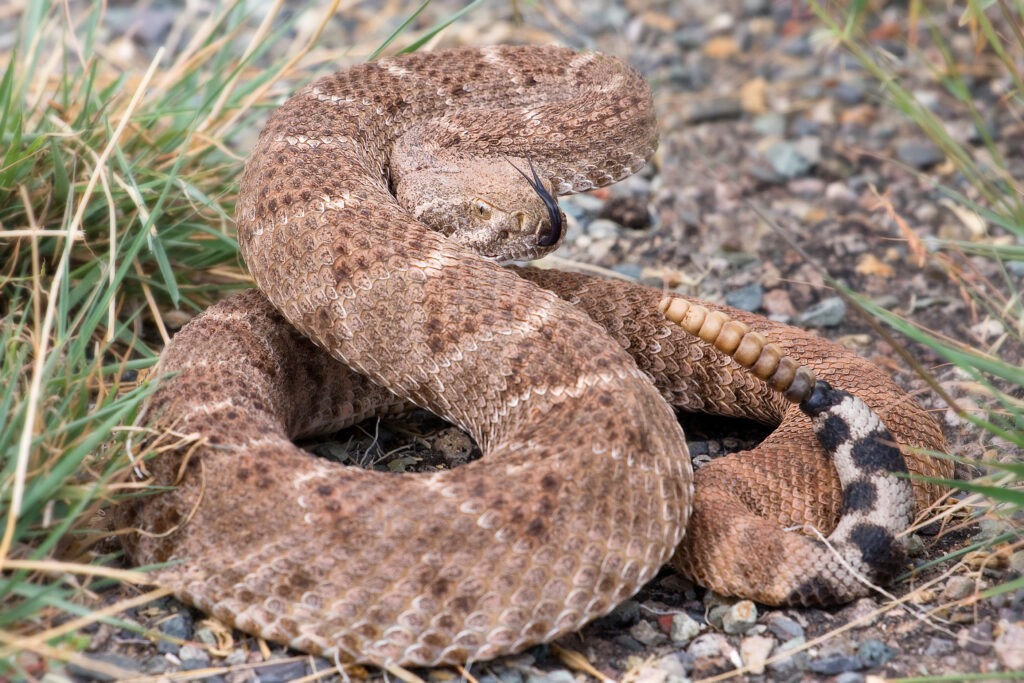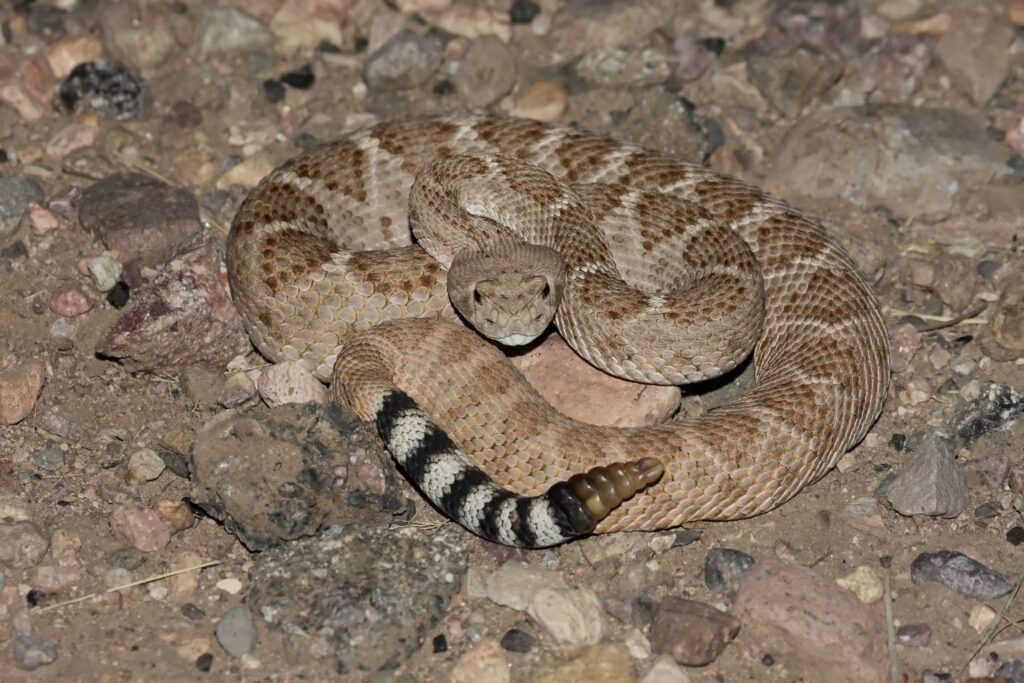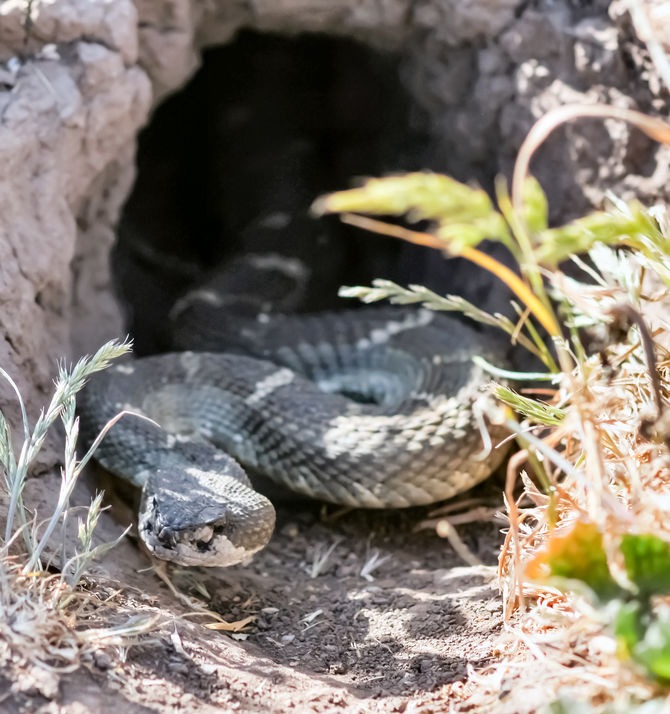
Anytime you hear a rattle in the bushes, watch out, because it could be a rattlesnake. If you find yourself face-to-face with one, you need to know if you have time to fight or flight. But can you outrun a rattlesnake?
I looked into it and here is what I found out.
You can outrun a rattlesnake, but you cannot outrun their strike, which is delivered at 1 foot per second, so back away slowly if you are within 4-5 feet of them. The average rattlesnake can move 2-3 mph, while the average human can run 10-15 mph, with the fastest humans running up to 28 mph.
But there is not a lot of data on rattlesnake speeds since they are ambush predators and typically do not pursue prey. However, it is likely that the average rattlesnake can travel at the 2-3 mph I mentioned, with the sidewinder rattlesnake being the fastest snake in the world, clocked at 18mph!
Rattlesnakes can attack in the blink of an eye.
But luckily they’re not too fast over longer distances. It’s not just a rattlesnake’s speed that makes it easy to get away from them. Here are some important things to know about rattlesnakes if you come face to face with them.
Would a Rattlesnake Chase You?
Rattlesnakes would not typically chase a human. Rattlesnakes are more defensive than offensive. They don’t want to be bothered and will stay away unless threatened.
The Forest Service of the United States Department of Agriculture states that the majority of rattlesnake bites occur when people try to handle them. Another common scenario is if people accidentally touch them when they’re walking or climbing. Source
When approached, some species of rattlesnakes are more prone to utilizing their camouflaged skin to slip away silently. However, if they are feeling threatened, rattlesnakes are more likely to stand their ground against you.

One of the first signs that you are threatening a rattlesnake is if you hear the buzzing sound of their rattle.
At the end of their tail, they have loose-fitting pieces of keratin that bounce against each other when positioned upright and vibrated. The rattlesnake produces this buzzing sound along with a hiss as a warning signal for other creatures to go away.
If the rattlesnake has chosen to stand its ground, it will often coil up into a striking position while hissing and rattling its tail.
If you come across a rattlesnake in this position, stop moving immediately and assess the situation. Make sure you look around to see if there are other rattlesnakes around before you move. You won’t want to escape one, just to run into another!
Once you have located a safe exit route away from any rattlesnakes, very slowly move in that direction. It is very important not to make any sudden movements.
Rattlesnakes need their venom to capture food, so they won’t use it unless they feel that they are in danger. However, if the rattlesnake has decided you are a dangerous threat, it will strike.
Sometimes this will result in the rattlesnake giving a “dry bite,” or a bite without venom. In a rattlesnake bite, they can discharge from one, both, or none of their fangs. That being said, you should always treat a rattlesnake bite as if it were venomous.
How Fast is a Rattlesnake’s Striking Speed?
Rattlesnakes are among the fastest strikers in the snake kingdom and can strike at 10 feet per second or even faster.
Rattlesnakes can accurately strike 1/3 to 1/2 their body length away. (Some rattlesnakes can even strike 2/3 their body length away.) As long as you are safely outside of that distance and can back away slowly, you have no reason to worry.
But if you are within that distance, the rattlesnake will likely feel threatened and may strike.
The worst things you can do if you are within striking distance include running away or attacking the rattlesnake. Any quick and sudden movements will threaten the rattlesnake, and as mentioned above, a rattlesnake’s strike is impossible for humans to outrun.
That being said, if you are out hiking with poles when you come across a rattlesnake and think it might strike, hold the pole out in between you and the rattlesnake. That way the rattlesnake will be more likely to bite the pole than you.
And of course, if you’re in an area likely inhabited by rattlesnakes, it’s always a good idea to wear heavy-duty boots and long pants to make biting more of a challenge for the snake.
Otherwise, there isn’t anything you can do except try to stay as still as possible if you are within striking distance. By staying perfectly still, the rattlesnake may decide to leave instead of striking you. If the rattlesnake does move and you are now out of striking distance, walk away slowly in the opposite direction.
Here is a video of a rattlesnake encounter in the mountains of Arizona. This hiker records the rattlesnake striking his camera twice before slithering away.
Note: If you encounter a rattlesnake, do not try to provoke it with your camera. We don’t recommend the behavior in this video but is important to learn from it.
Remember to leave it alone and back away slowly!
What to Do if a Rattlesnake Bites You
You’ll need to act fast if a rattlesnake bites you. First, get out of striking distance and call 911 immediately.
The Mayo Clinic recommends the following steps while you wait for medical help:
- Move away from the snake’s striking distance.
- Remain as calm as possible to help slow the spread of venom. Keep your heart rate slow and breathe deeply.
- Remove any constricting jewelry and clothing before the bite starts to swell. This includes rings, watches, and bracelets.
- Position yourself, so that the bitten area is at or below the level of your heart.
- Disinfect/clean the wound with soap and water. Cover it loosely with a clean, dry bandage.
Caution:
- Do not use a tourniquet or apply ice.
- Do not cut the wound.
- Do not attempt to suck the venom out of the wound.
- Do not drink caffeine or alcohol. These could speed your heart rate, and thus your body’s absorption of venom.
- Do not try to capture the snake. Try to remember its color and shape so that you can describe it. An accurate description will help you receive the proper treatment once help arrives. If you have a camera or smartphone with you, try to take a picture of the snake from a safe distance to help identify it.”
It is also wise to note the time of the bite so you can report it to the healthcare providers treating you.
The video below goes into more detail about what could happen if a rattlesnake bites you (including different species of rattlesnakes). It also shares real stories of people who have been bitten by rattlesnakes:
What To Do If A Rattlesnake Bites Your Dog or Cat
First of all, you should look for open wounds. Check the pet’s head, face, and limbs first. These areas are the most common targets. Snake attacks will leave behind a pair of evenly-spaced puncture wounds.
Once the bite begins to swell, you may not be able to see the punctures clearly, but you will see an inflamed and irritated area.
Even though our pets might be faster than us, they still won’t be able to avoid a bite from a rattlesnake if they get within striking distance. Frequently, if your pet gets bitten outside, you won’t see the snake that bit it. This means that you need to be aware of the symptoms of rattlesnake bites in dogs and cats.
Experts from vetrinaryemergencygroup.com have created a guide that can help pet owners identify a snake bite.
Rattlesnake wounds may bleed heavily because of the toxins.
Their venom contains anticoagulant properties, which prevent the body from forming scabs and slowing down bleeding. Your pet may also show signs of weakness, paralysis, and ataxia.
If you believe that your dog or cat has been bitten by any snake, call an emergency veterinarian immediately. In most cases, rattlesnake bites are far more likely to kill a dog or cat compared to a human. The vet can tell you what to do once the initial treatment has been given.
When are Rattlesnakes Most Active?
Rattlesnakes love warm weather, so they are most active from late spring through early fall when temperatures are around 70-90˚F. However, daytime summer temperatures can get too hot for rattlesnakes, so they will become nocturnal during the summer months.
Rattlesnakes will typically disappear as early as September or as late as December into a state called brumation.
Brumation is similar to hibernation, but it is a little different. Snakes largely go inactive during the winter months, so you’re unlikely to encounter one during this time. Even if you do see one, it will usually be too sluggish to react to your presence and probably won’t strike.
A good rule of thumb is that most rattlesnakes won’t come out if it’s below 60˚F, but you should always be cautious no matter the season.
Where Do You Find Rattlesnakes?

In regards to residential areas, rattlesnakes can be found anywhere where they can find shade and food. So, you can find rattlesnakes in your bushes, behind rock or woodpiles, under pool water pumps, under your deck, and behind anything leaning up against your house.
In the United States of America, Texas and Arizona are the two states with the most species of rattlesnakes. With this knowledge in mind, it is not surprising that Arizona is frequently the state with the most rattlesnake bites per year.
However, all U.S. states run the risk of having rattlesnakes in their grasslands and rocky terrain.
While they love the heat, rattlesnakes usually don’t want to be in the direct sunlight. Often they like to lay down on cool surfaces in the shade.
Rattlesnakes eat rodents and birds, so if you have those in your yard, you will probably have rattlesnakes too. They are also attracted to water sources because that is where they can find more prey.
What You Can Do to Keep Rattlesnakes Out of Your Yard
The first thing to do is remove as many rattlesnake hiding places as you can. This includes moving any piles, avoiding rock formations in your decoration, and keeping your grass short so that you can see if there are any rattlesnakes in the grass.
Outrunning a rattlesnake in nature is one thing, but it’s quite different if you find one in your own backyard. Once there are cramped spaces and obstacles in the way, it’s much harder to put distance between you and the snake. So in this case, the best way to avoid a confrontation is to make your yard unwelcoming to snakes.
Choose plants that don’t provide overly shaded areas.
It also helps if they can be cut or trimmed easily. Hedges and thick bushes provide an easy hiding spot for snakes. As a rule of thumb, if you can’t see the ground under your bushes, it could attract a snake.
Next up, you should remove food and water sources. Get rid of any rodents that might be visiting your house, keep bird feeders off the ground, and limit water sources that will attract frogs. Fix any leaky faucets or places in your yard that are overwatered and will allow water to pool up.
You can also build a rattlesnake fence to help keep rattlesnakes out of your yard.
For instance, rattlesnakes cannot scale smooth surfaces without any notches or protrusions. For this reason, concrete or metal walls are good choices. They just need to be high enough that a snake cannot stretch over the top. For most rattlesnakes, that means it should be at least 3 feet tall. However, a 4-5 foot tall fence wouldn’t go amiss either.
If you want a simpler solution, you can also install smooth steel mesh with a small gap size. This will keep your yard looking free and open, while still providing a layer of protection.
Avoid using rattlesnake repellants because their effectiveness is questionable and many have ingredients that can be toxic to people and pets.
It is also good to avoid using rattlesnake traps because they will trap much more than rattlesnakes. Then again, if you are looking to reduce the number of rodents, frogs, or lizards in your yard as well, rattlesnake traps might actually work well for you.
If you are considering rattlesnake traps, you need to do your research to find the best traps. The best traps are the ones that will not hurt the snake and most importantly will not put you in a position where you can easily be bitten.
When it comes to trapping and relocating rattlesnakes, however, it is best to go to the professionals.
Technically you can trap them on your own, but it is a very dangerous activity, and getting your skin too close to the snake can be a very fatal mistake.
Here is a video example of someone trapping and relocating a rattlesnake with instructions.
Conclusion
Outrunning a rattlesnake is a possibility since the average human can run 10 mph and most rattlesnakes move more slowly if they choose to pursue at all (which is unlikely.)
However, this is not the best strategy. The lightning-quick strike from a rattlesnake cannot be outrun, therefore, it is best to be aware of when rattlesnakes are most active and understand when they feel threatened.
If you are seeking to keep your yard snake-free, make sure you contact the professionals to remove and relocate a rattlesnake.
If you do decide to use a trap or other methods for repelling rattlesnakes, always make sure to keep yourself safe and never in a position where you will be forced to try to outrun a rattlesnake.
